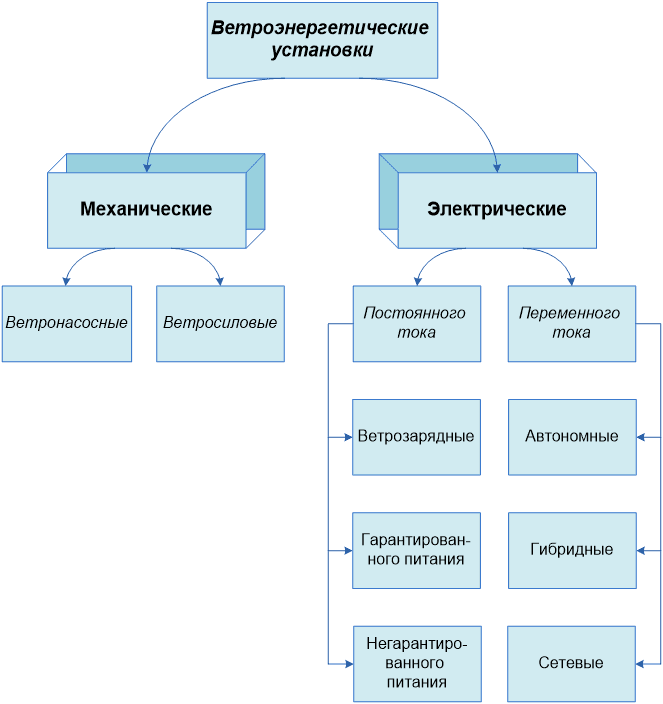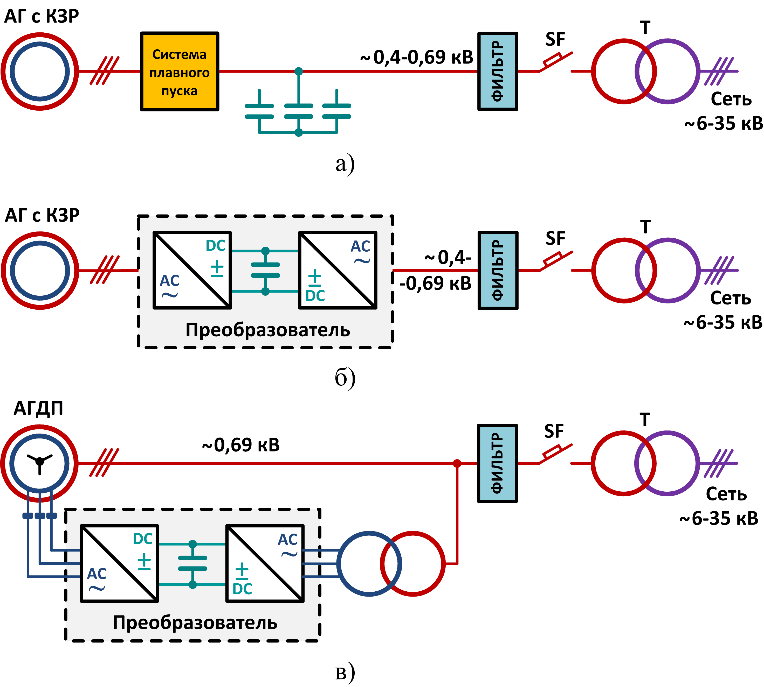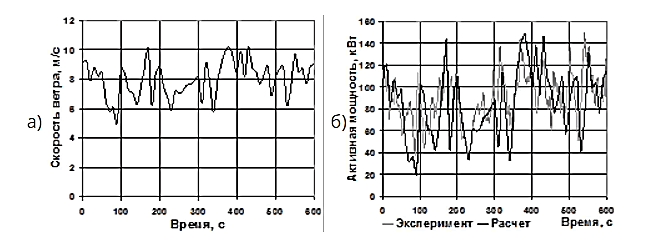Abstract
List of contents
- Introduction
- 1. The relevance of wind energy
- 2. Goals and objectives
- 3. Asynchronous generator of dual power supply
- 4. The investigated model
- Conclusion
- References
INTRODUCTION
The object of research in this article is a wind power plant based on an asynchronous dual-power generator.
Currently, due to the problem of depletion of reserves of fossil fuels (coal, natural gas, peat, oil, etc.), there is a tendency in the world to develop and introduce renewable energy sources (RES), of which wind power plants (wind turbines) are the most promising.
1 THE RELEVANCE OF WIND ENERGY
The main advantage of using wind energy is that wind energy itself is not only renewable, but also available for storage and processing, compared with traditional energy sources such as oil, gas, etc. It is important to take into account the economic benefits. There can be no unambiguous estimates regarding specific economic indicators yet due to the variety of systems operating with different productivity. In short, the advantages of wind turbines can be identified by several points:
1. Ecological cleanliness
2. The operation of wind power plants does not provide for harmful emissions polluting the atmosphere
3. Compactness
4. The autonomy and independence of such systems from auxiliary communications and resources
Wind power is an unregulated source of energy. The production of wind energy depends on the strength of the wind, a factor characterized by great variability. Accordingly, the output of electricity from the wind generator to the power system is highly uneven, both in daily and weekly, monthly, annual and multi-year terms [1].
Modern wind energy has a number of problems that have a negative impact on improving the efficiency of energy saving. The most relevant of them are the following:
– ensuring the long-term operation of wind power units;
– ensuring efficient use of wind energy;
– stabilization of the frequency of electricity generated by wind turbines.
The single rated power of modern wind turbines ranges from several kilowatts to 10 MW. As a rule, most wind power plants are three-bladed with a horizontal axis of rotation parallel to the direction of the wind flow. Based on the current state standard GOST R 51990, wind turbines, depending on power, are divided into four groups: the first group (high power) over 1 MW; the second (medium power) from 100 kW to 1 MW; the third (low power) from 5 to 100 kW; the fourth (very low power) less than 5 kW [2].
Wind turbines are classified according to many characteristics, the main of which are: the type of energy produced, power, a sign of operation with a constant or variable speed of rotation of the wind wheel (VC), etc. According to GOST R 51990, wind turbines, depending on the type of energy produced, are divided into two groups: mechanical and electrical. Electric wind power plants, in turn, are divided into DC and AC wind turbines (Fig. 1.)

2 GOALS AND OBJECTIVES
The main task is to obtain the maximum possible power from the wind farm.
The control system is required to perform various actions by its nature from continuous control with rapid response to discrete emergency protective actions and processes with strictly sequential operations. Since different control functions affect the safety and reliability of the wind turbine operation to varying degrees, the system cannot be optimal in all respects.
The main technical requirements for the wind turbine control system when working in parallel with the network are presented below:
– operability under specified operating conditions;
– automatic start-up and subsequent synchronization;
– rotor power and speed control;
– control of own subsystems and wind turbine equipment, periodic self-monitoring;
– formation and issuance of commands for the control of wind turbine element systems.
The objectives of the management system are:
– frequency maintenance (active power);
– voltage maintenance (reactive power);
– electrical energy quality indicators;
– protection and automation of wind power plants (wind farms).
When considering the above requirements, it is necessary to take into account that the wind is characterized by variability in magnitude and direction, therefore, power pulsations of a single wind turbine should be smoothed out by a large number of aggregates.
The purpose of the work is to study the basics of wind energy, methods for controlling the output power of a wind turbine, creating a real working model of the system and its modeling. The main objective of this work is to develop a simulation model of an autonomous wind energy system using the MATLAB/Simulink package.
3 ASYNCHRONOUS GENERATOR OF DUAL POWER SUPPLY
In practice, based on the current state of wind power. the most common types of wind power plants can be distinguished:
– Wind turbines based on asynchronous generators with a short-circuited rotor (AG with KZR);
– Wind turbines based on asynchronous generators of dual power supply;
– Wind turbines based on synchronous generators with a classical DC excitation winding;
– Wind turbines based on synchronous generators with permanent (permanent) magnets on the rotor (With GPM).
As a rule, AG with KZR are installed on wind turbines with a capacity of up to 1 MW. Wind turbines with automatic transmission are present in the power range from 1 to 5 MW. Wind turbines with SG with permanent magnets, as well as with a classical excitation winding, are used at a power of more than 3 MW.
Simplified diagrams of the main electrical connections of wind turbines with asynchronous generators are shown in Fig. 3.
AG with direct connection to the electric power station (Fig. 2a) are used at a constant angular rotation speed regardless of wind speed. A key feature of such wind turbines is the presence of additional capacitor banks necessary to compensate for reactive power consumption. The advantages include simplicity and reliability, as well as relatively low cost compared to other types of VA. The main disadvantages include: uncontrolled consumption of reactive power, low efficiency for wind speeds other than nominal, transmission of wind speed fluctuations in the EES, as well as the presence of high mechanical stress. The wind turbine control system with AG with KZR, specifically the control of the generation output power, uses the following aerodynamic principles, such as speed loss control (passive control) and pitch control [4].

Connecting an AG with a KZR to the power system via a semiconductor IF (see Fig. 2b) is used at a variable angular rotation speed, which allows generating an industrial frequency voltage. The control is performed in the wind turbine data with pitch control and with IF control on the side of the generator voltage. The disadvantages include a decrease in the efficiency of the machine at a shaft rotation speed lower than the nominal value, the presence of a problem of reactive power regulation, as well as problems with the quality of the generation voltage due to the presence of a frequency converter.
In Fig. 2b presents a wind turbine circuit based on an asynchronous generator with dual power supply. AGDP is an asynchronous generator with a phase rotor. The three-phase stator winding of the generator is connected via a block step-up transformer to the EES. A semiconductor IF is connected to the rotor winding, which is necessary to change the angular frequency of rotation in a certain range. This range is limited both by the technical characteristics of the IF itself and by the mechanical parameters of the VA. A positive feature is the possibility of regulating the power factor and reactive power of the AGDP. The disadvantages include the presence of a brush machine with a phase rotor, which affects the reliability of the wind turbine, as well as problems with the quality of the voltage in the network due to the use of IF. From an economic point of view, wind turbines with automatic transmission are cheaper than installations using expensive frequency converters in the generator voltage circuit.
The wind turbine control system with AGP includes pitch control, control with maximum power limitation, or an MPPT controller, as well as control of the IF circuit of the phase rotor [3].
4 THE INVESTIGATED MODEL

Solving such systems of equations explicitly presents significant difficulties, therefore, the MatLab package was used to prepare the model, which allows you to organize models from blocks of elements and display its structure graphically. The Wind Turbine Blockset application blocks were used to describe the wind load, the aerodynamics of the rotor and the mechanical drive of the wind turbine. A number of blocks describing, for example, the operation of the AG and its reactive power compensation system have been finalized. A block of the wind turbine starting device and a control unit have been created that connects the wind turbine to the network at a moment with a given rotor rotation speed [5].



CONCLUSIONS
In this work, the basics of wind power were studied, its relevance to date is shown, the main goals and objectives of the wind energy industry are considered. Wind energy is a promising area of energy and engineering in general from the point of view of economics and ecology, since it is a cheap type of energy that uses a renewable resource wind, and at the same time does not pollute the environment.
In the work, a detailed analysis of modern wind power plants was carried out, as a result of which it was found that the most rational and economically advantageous are wind turbines with asynchronous generators of dual power.
The mathematical model of the EES with wind turbines based on asynchronous machines, allows you to evaluate the connectivity and collaboration of such wind turbines and wind turbines based on them as part of the EES.
When writing this abstract, the master's work has not yet been completed. Final completion: May 2023. The full text of the work and materials on the topic can be obtained from the author or his supervisor after the specified date.
LIST OF SOURCES
- Stychinsky, Z. A. Renewable energy sources: Theoretical foundations, technologies, technical characteristics, economics / Z. A. Stychinsky, N. I. Voropai. Magdeburg: Publishing House of the Otto-von-Guericke University of Magdeburg (Die Otto-von-Guericke-Universitat Magdeburg) docupoint GmbH, 2010. 209 p.
- GOST R 51990-2002. Unconventional energy. Wind energy. Wind power installations. Classification. Introduction. 01.07.2003. Moscow: Publishing House of Standards, 2003. 8 p.
- Sokolovsky, Yu.B. Modern wind power installations (review) / Yu.B. Sokolovsky, A.Yu. Sokolovsky // Electrical Engineering: online electronic scientific journal. Tom 2. Ή 4. 2015. Pp. 27-38.
- Nikishin A.Yu., Kazakov V.P. MODERN WIND POWER INSTALLATIONS BASED ON ASYNCHRONOUS MACHINES // Modern problems of science and education. 2012. Ή 6.;
- GOST R 51237-98. Unconventional energy. Wind energy. Terms and definitions. Introduction. 30.06.1999. Moscow: Publishing House of Standards, 1999. -12 p..
